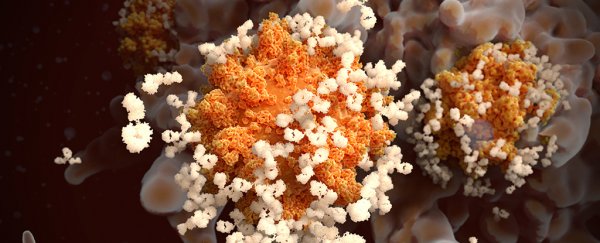Days after a SARS-CoV-2 infection, an otherwise healthy teenage girl suddenly had trouble breathing. COVID-19 appeared to have paralyzed her vocal cords.
The girl needed a surgical tracheostomy – an opening in her windpipe below her voice box – to support her breathing for over a year. According to a new case report on the event, COVID's impact on the nervous system may cause vocal cord paralysis in rare cases.
The authors say this is the first case of vocal cord paralysis in a teenager after a COVID-19 diagnosis, though there have been reports of the condition in adults.
"The virus has known neurologic complications, including headache, seizure, and peripheral neuropathy," write otolaryngologists Danielle Larrow and Christopher Hartnick from Mass Eye and Ear at Harvard Medical School.
"The current case reveals that vocal cord paralysis may be an additional neuropathic sequela of the virus."
Thirteen days after a positive SARS-CoV-2 test, the 15-year-old girl presented to a hospital emergency department. Her initial symptoms including congestion, fever, and fatigue, improved after five days. But she reported having trouble breathing suddenly nine days after the positive test, especially when active.
Emergency department doctors noted her breathing was rapid and noisy when inhaling, indicating obstructed airflow, though her oxygen levels were normal. Tests for SARS-CoV-2 and other respiratory infections were negative.
The patient, who had a history of asthma and anxiety, was given steroids and bronchodilators for a suspected asthma attack, but it didn't help.
Otolaryngologists examined her vocal cords and diagnosed paradoxical vocal fold motion (PVFM), where the vocal cords close instead of opening while a person is breathing in. She began speech therapy to treat this involuntary closure, but her symptoms didn't improve and it became clear they didn't match the typical signs of PVFM.
She continued to have trouble breathing and developed new problems like difficulty swallowing, weakness on one side, tingling and numbness, and unsteady walking, so the girl was admitted to a pediatric hospital for a thorough evaluation.
Otolaryngologists examined her vocal cords again, and this time they diagnosed bilateral vocal cord paralysis, essentially meaning both her vocal cords were unable to move. But they still couldn't find a cause for the paralysis.
Results from a battery of tests ruled out infections and neurological disorders. Her brain and spine scans showed no obvious issues that could be related to her symptoms, nor did tests on her swallowing.
Based on their findings, doctors concluded that the teenager's previous COVID-19 infection appeared to have weakened her vocal cords, and may also be the cause of her numbness and weakness on one side.
Botulinum toxin injections into her throat muscles – a method that's shown efficacy in treating some throat pathologies in children – was unsuccessful in alleviating her breathing issues.
Eventually the girl had surgery for a tracheostomy, where a small opening is made in the trachea (windpipe) to assist breathing. And finally, her breathing got better.
Her weakness, tingling, and numbness improved over time, raising the likelihood that they were related to her past COVID-19 infection.
The medical team tried a few times to see if she could breathe without the tracheostomy, but it wasn't until the 15th month after insertion that they were able to remove it safely.
"She was having her senior prom a year and a quarter to the date of when she lost her function, and she told me she was not going to go to the prom with her tracheostomy in place," says Hartnick.
"We decided to intervene so that she could graduate high school and go to her prom tracheostomy-free, which she did."
The case report has been published in Pediatrics.
